EMAIL SUPPORT
dclessons@dclessons.comLOCATION
USControl Plane Operation
In Cisco Viptela, OMP protocol is used for Control plane operation. OMP allows secure and scalable fabric across different type of transport like MPLS, layer2 VPN, P2P Connection, Internet as well as LTE connectivity.
vSmart is the component of SDWAN responsible for Control plane Operation. vSmart takes all routing information from its clients, calculates the best path information based on configured policy and then advertise the result to all WAN edge.
For Control plane operation, Control plane tunnels are created, which are encrypted and authenticated via Datagram Transport layer Security (DTLS) or Transport layer Security (TLS).
Below figure describes how OMP is encrypted by DTLS or TLS.

DTLS or TLS connections are maintained between all personas in SD-WAN overlay (vBond, vSmart, WAN Edge, and vManage). These tunnels are negotiated using SSL Certificates, where each component will authenticate other end and establish a one-way tunnel. In this negotiation each device will validate that the received certificate is signed by a trusted root CA and has a valid serial number with matching organization name.
Below figure shows DTLS tunnel Authentication process
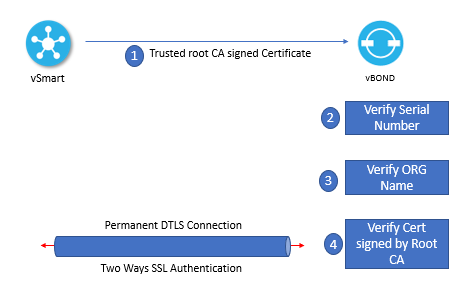
By Default, DTLS protocol is used for communication over UDP port 12346. TLS is also supported if there is specific requirement for secure tunnel. vSmart and vmanage are deployed as virtual machine that support multiple cores (up to eight). Each core has a base port associated to it. Inbound DTLS/TLS connection will initially target port is 12346, how ever they can be transitioned to one or other base port, based on this technology, vManage and vSmart are able to distribute control connection load across CPU. Below table shows core-to-port mapping.
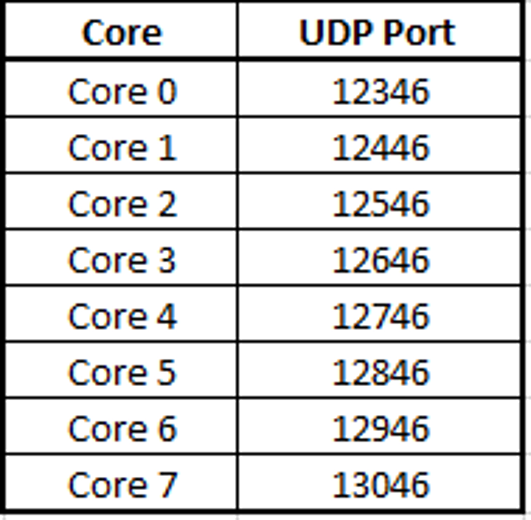
Once Control plane are up other protocol can also use this session for other purpose, those protocol can be SNMP, Netconf etc.
Overlay (OMP) Routing Overview
In Cisco Viptela Solution, the Overlay network is managed and controlled by Overlay Management Protocol (OMP). This OMP protocol establish and maintain the Viptela Control plane and provides following Services:
- Orchestration of
- Routing and secure connectivity between sites
- Service chaining
- VPN topologies (Segmentation)
- Distribution of Routes
- Distribution of data-plane security parameters
- Central Control and Distribution of routing policies
OMP is the control protocol that is used to exchange routing, policy, and management information between vSmart controllers and WAN Edge routers in the overlay network. These devices automatically initiate OMP peering sessions between themselves using system IP addresses as endpoints for the OMP session.
OMP provides an efficient way to manage service traffic based on the location of logical transport endpoints. This method extends the data plane and control plane separation concept from within routers across the network. OMP distributes control plane information along with related policies. A central vSmart controller makes all decisions related to routing and access policies for the overlay routing domain. OMP is then used to propagate routing, security, services, and policies that are used by the edge devices for data plane connectivity and transport.
The SD-WAN overlay network supports BGP, EIGRP, and OSPF unicast routing protocols. You can configure these protocols on WAN Edge routers to provide reachability to networks at their local sites. Provisioning BGP, EIGRP, and OSPF enables routing on the service side of the network. To set up routing on the WAN Edge router, you need to provision one VPN, or multiple VPNs if segmentation is required. Within each VPN, you need to configure the interfaces that participate in that VPN and the routing protocols operating in that VPN. Because vSmart controllers never participate in a local site network, you do not need to configure BGP, EIGRP, or OSPF on these vSmart controllers.
On vSmart controllers and WAN Edge routers, OMP advertises to its peers the routes and services that it has learned from its local site, along with their corresponding transport location mappings, which are called TLOCs. These routes are called OMP routes or vRoutes to distinguish them from standard IP routes. The advertised routes are a tuple consisting of the route and the TLOC associated with that route. The vSmart controllers learn the topology of the overlay network and the services available in the network through OMP routes.
OMP interacts with traditional routing at local sites in the overlay network. It imports information from traditional routing protocols, such as OSPF, EIGRP, and BGP, and this routing information provides reachability within the local site. The importing of routing information from traditional routing protocols is subject to user-defined policies.
Because OMP operates in an overlay networking environment, the notion of routing peers is different from a traditional network environment. From a logical point of view, the overlay environment consists of a centralized controller and several WAN Edge routers. Each WAN Edge router advertises its imported routes to the centralized controller and is based on policy decisions. This controller distributes the overlay routing information to other WAN Edge routers in the network. WAN Edge routers never advertise routing information to each other, either using OMP or any other method. The OMP peering sessions between the centralized controller and the WAN Edge routers are used exclusively to exchange control plane traffic; they are never, in any situation, used for data traffic.
Registered WAN Edge routers automatically collect routes from directly connected networks and static routes as well as routes learned from the Interior Gateway Protocol (IGP). You can also configure WAN Edge routers to collect routes learned from BGP.
OMP performs path selection, loop avoidance, and policy implementation on each local device to decide which routes need to be installed in the local routing table of any edge device.
OMP uses three route types to learn and send routing information across the overlay: OMP routes, TLOC routes, and network service routes.
OMP also supports graceful start, which allows WAN Edges to cache forwarding information if connectivity to the vSmart controllers become unavailable. In this case, WAN Edge will continue to use routing information tat was last received. This feature is enabled by default, on vSmart controller and WAN Edge routers with a default timer of 12 hrs, and this timer can be modified with minimum value of 1 sec and max value of 7 days.
OMP Route Advertisements
As soon as vEdge learns the routes are services from local site, it advertises these all information to vSmart controller along with its transport location mapping called as TLOC which are further called as OMP routes or routes.
It is due to OMP routes, vSmart learn the topology of the overlay network and services available in that network. As all vEdge devices advertises its imported to vSmart Controller and based on policy decisions the controller further distributes the routing information to other edge devices. The Edge devices will never advertises its routing information directly to another vEdge devices.
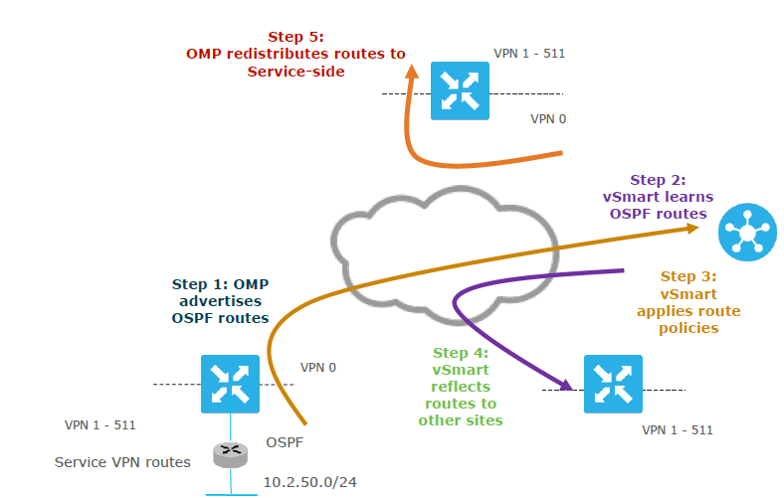
OMP Route Types
There are Three Types of Routes
OMP Routes (vRoutes)
- Prefixes learned from site-local (i.e. service side)
- Like prefixes of BGP
TLOC’s
- Transport Locator
- Ties OMP route to physical location (i.e. vEdge)
- Like next-hop of BGP
Service Routes
- Service Chaining
- Ties OMP route to an advertised network service
OMP routes (vRoutes)
OMP routes are those routes or prefixes which are used to establish the reachability between end points. These OMP routes represent a services in DC, Service in Branch Office or it is a collection of hosts in any location of overlay network.
At each site, vEdge router advertise the OMP routes to vSmart controller and these routes contain routing information that vEdge has learned from that local site.
Following are OMP routes that is advertised by vEdge at local site.
- Connected (Direct)
- Static
- BGP
- EIGRP
- Locator/ID Separation Protocol (LISP)
- OSPF (interarea, intra-area, and external)
- OSPFv3 (interarea, intra-area, and external)Intermediate System-to-Intermediate System (IS-IS)
OMP routes advertises the following attributes:
- TLOC—Transport location identifier of the next hop for the route. It is similar to the BGP NEXT_HOP attribute. A TLOC consists of three components:
- System IP address of the OMP speaker that originates the OMP route
- Color to identify the link type
- Encapsulation type on the transport tunnel
- Origin—Source of the route, such as BGP, OSPF, connected, and static, and the metric associated with the original route.
- Originator—OMP identifier of the originator of the route, which is the IP address from which the route was learned.
- Preference—Degree of preference for an OMP route. A higher preference value is more preferred.
- Service—Network service associated with the OMP route.
- Site ID—Identifier of a site within the Viptela overlay network domain to which the OMP route belongs.
- Tag—Optional, transitive path attribute that an OMP speaker can use to control the routing information it accepts, prefers, or redistributes.
- VPN—VPN or network segment to which the OMP route belongs.
With the Help of following command, we will be able to see the OMP Routes
vEdge1# show ip route

You configure some of the OMP route attribute values, including the system IP, color, encapsulation type, carrier, preference, service, site ID, and VRF. You can modify some of the OMP route attributes by provisioning a control policy on the vSmart controller.
TLOC Routes:
Transport independence is one of the cornerstones of the SD-WAN solution. Using the power of abstraction, SD-WAN can build secure overlay fabric on top of any public or private transport. IPsec encryption is used for the secure overlay fabric. TLOCs represent an abstraction layer for defining IPsec tunnel endpoints. Because IP addressing is not deterministic and can change, especially on DHCP-enabled broadband circuits, SD-WAN fabric uses system IP, color, and encapsulation for defining IPsec tunnel termination endpoints, which allows independence from individual transport IP addressing.
TLOC is identified by 3-tuple which is
- System IP
- Color
- Encapsulation
TLOCs are advertised as TLOC routes in the OMP messages between the WAN Edge routers and the vSmart controllers. vSmart controllers reflect TLOC reachability between the WAN Edge routers across the fabric. In the absence of control policies on the vSmart controllers, all TLOC routes are advertised by the vSmart controllers to all WAN Edge routers. Control policies can be used to block certain TLOC route advertisements or to modify their attributes before passing them along. When they are advertised, WAN Edge routers can construct direct IPsec tunnels between themselves. By default, WAN Edge routers construct a full-mesh topology.
TLOC routes identify transport locations, which are locations in the overlay network connected to physical transport, such as the point at which a WAN interface connects to a carrier. The OMP advertises each TLOC separately.
TLOC advertises the following attributes:
- TLOC private address—Private IP address of the interface associated with the TLOC.
- TLOC public address—NAT-translated address of the TLOC.
- Carrier—An identifier of the carrier type, which is generally used to indicate whether the transport is public or private.
- Color—identifies the link type.
- Encapsulation type—Tunnel encapsulation type.
- Preference—Degree of preference that is used to differentiate between TLOCs that advertise the same OMP route
- Site ID—Identifier of a site within the Viptela overlay network domain to which the TLOC belongs.
- Tag—Optional, transitive path attribute that an OMP speaker can use to control the flow of routing information toward a TLOC. When an OMP route is advertised along with its TLOC, both or either can be distributed with a community TAG, to be used to decide how send traffic to or receive traffic from a group of TLOCs.
- Weight—Value that is used to discriminate among multiple entry points if an OMP route is reachable through two or more TLOCs.
IP address used in TLOC is fixed system IP address of vEdge Router. Let’s understand the TLOC
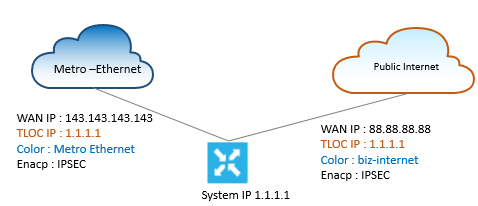
The encapsulation is that used on the tunnel interface. It can be either IPsec or GRE. vEdge router that has two WAN connections and it has two TLOCs. The system IP address of the router is 1.1.1.1. The TLOC on the left is uniquely identified by the system IP address 1.1.1.1, the color metro-ethernet, and the encapsulation IPsec, and it maps to the physical WAN interface IP address 143.143.143.143. The TLOC on the right is identified by the system IP address 1.1.1.1, the color biz-internet, and the encapsulation IPsec, and it maps to the WAN IP address 88.88.88.88.
Service Routes
Service routes are those routes that represent any services that are connected to local sites. Routes of network-services connected to vEdge.
Service Routes advertises a specific service to SDWAN overlay network. This advertisement is also used for service chaining policies. Service chaining allow data traffic to be routed to a remote site through one or more service, such as firewalls, IPS/IDS, load balancers. These services are utilized on a per VPN basis.
In order to enable service chaining, following workflow should be used:
- The Network administrator defines the service via a feature template.
- WAN Edge router advertise the service available to vSmart controller along with its OMP and TLOC routes.
- Network admin applies a policy defining traffic that must flow through these advertised services. Traffic will always be process by the service before being forwarded to final destination.
Let’s understand the below example to see how service changing works:
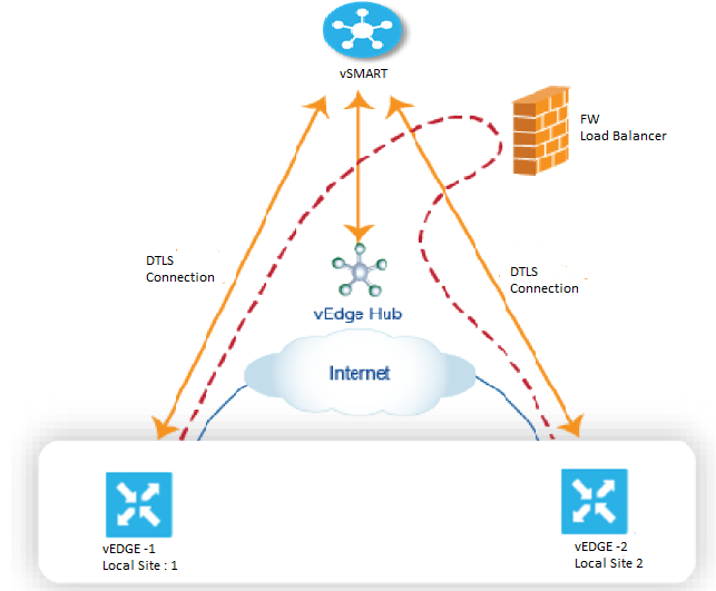
Here, Client network has Central hub and two remote sites. Business wants that all traffic from remote site must be inspected by firewall at Central hub. For that to achieve, Network admin define a service chaining policy to enable this traffic flow.
The Site offering the service (Hub) will advertise a service route via SAFI – Subsequent Address family Identifier in the OMP network layer reachability information (NLRI). This information is advertised to vSmart controller and is then propagated to WAN Edges.
Attributes of Service Routes:
-
Each service route SAFI has the following attributes:
- VPN ID: VPN ID identifies the VPN that the service belongs to.
- Service ID: Service ID (svc-id) identifies the service being advertised by the service node. The SD-WAN software has the following predefined services:
- FW: firewall (maps to svc-id 1)
- IDS: intrusion detection system (maps to svc-id 2)
- IdP: identity provider (maps to svc-id 3)
- netsvc1, netsvc2, netsvc3, and netsvc4: reserved for custom services (they map to svc-id 4, 5, 6, and 7, respectively)
- Label: For traffic that must traverse a service, the vSmart replaces the label in the OMP route with the service label to direct the traffic to that service.
- Originator ID: This is the IP address of the service node advertising the service.
- TLOC: TLOC is the transport location address of the WAN Edge that is hosting the service.
- Path ID: This is the identifier of the OMP path.
Below is the figure that describes all routes in one diagram.
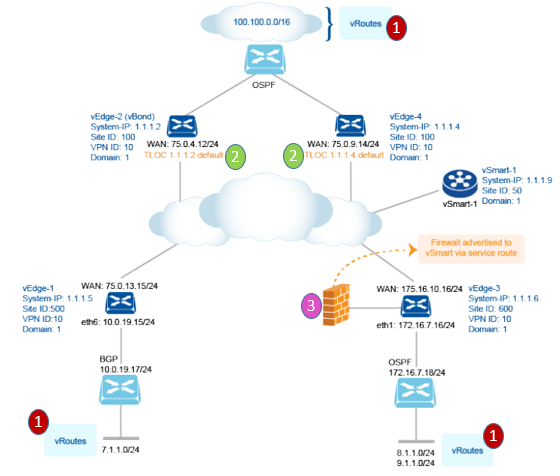
OMP Routes: Route Distribution
When OMP is enabled, it automatically redistributes following routes that it learn either locally or from its routing peers.
- Connected
- Static
- OSPF intra-area routes
- OSPF inter-area routes
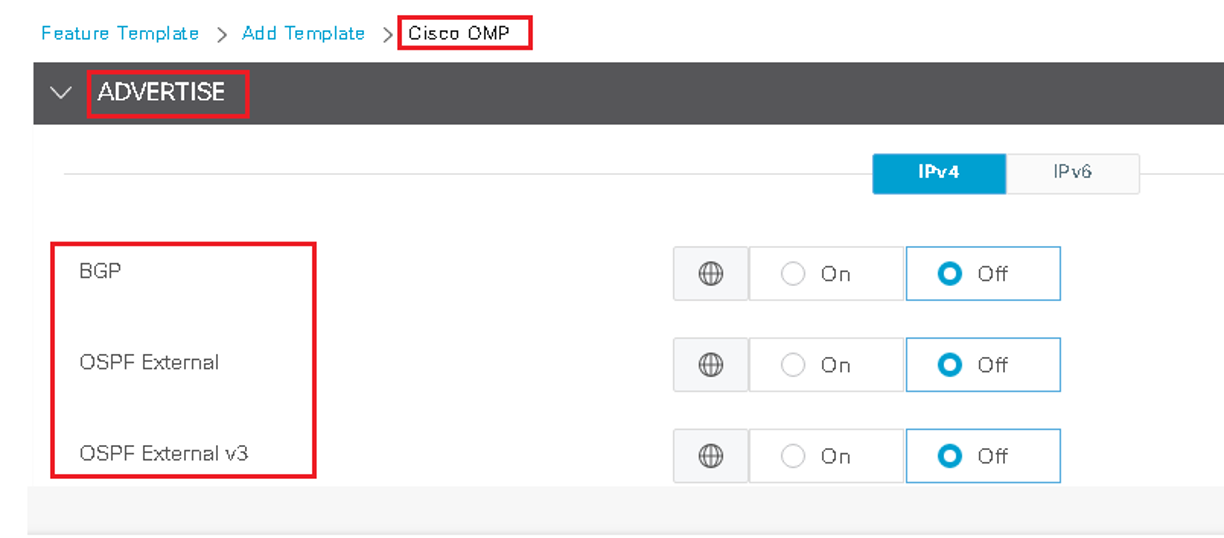
In order to avoid routing loops, and less optimal routing, when redistribution is done following types of routes requires explicit configuration.
- BGP
- OSPF external routes
Now to avoid distributing very large number of routing information from an Edge to overlay network, Routes learned from on vEdge via OMP are not automatically redistributed in to another routing protocols on that routers. If redistribution is desired redistribution must be enabled locally on each vEdge router.
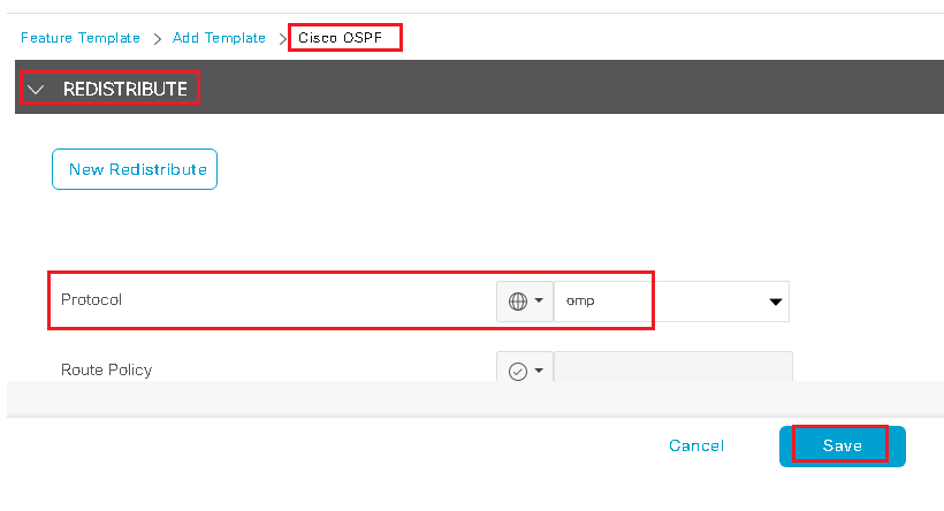
To indicate the route origin, OMP includes or set the origin and sub-origin type in its advertisement and while selecting routes, vEdge and vSmart considers the origin a sub-origin types.
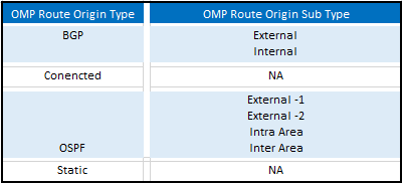
OMP also carries the metric of original routes with Metric 0 is said as directly connected routes.
Manual Commands for Redistribution are
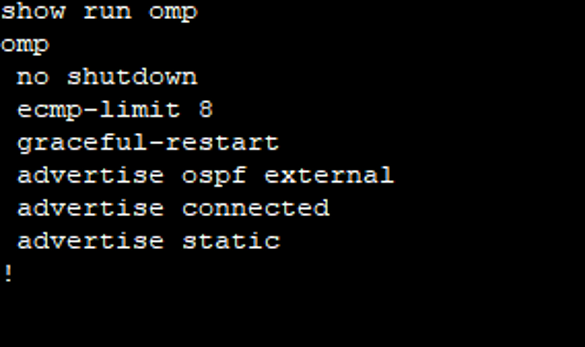
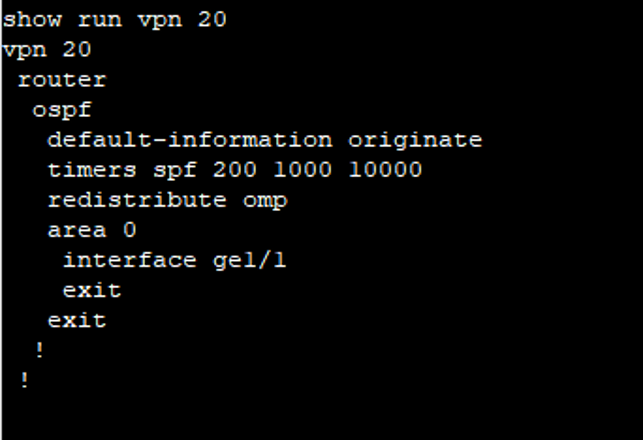
OMP also carries metric from the redistributed protocol, below table list WAN Edge default Administrator Distances.
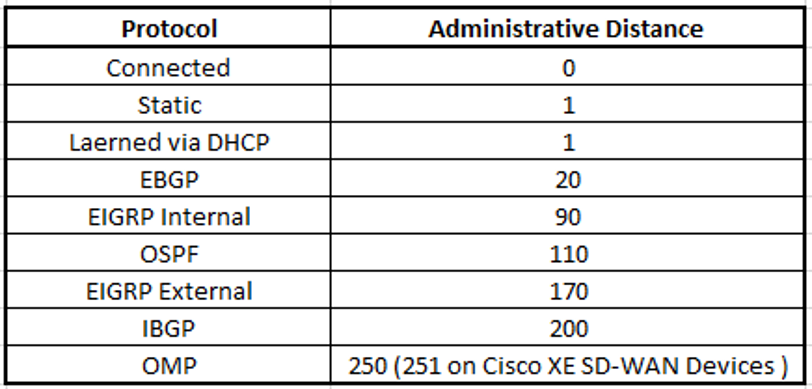
If the network has multiple exit points to the WAN can suspect routing loops. This commonly occurs when two or more routers have manual redistribution from WAN routing protocol and the LAN routing protocol.
Below figure shows, two WAN Edges and routing protocol like OMP and OSPF are doing manual redistribution.
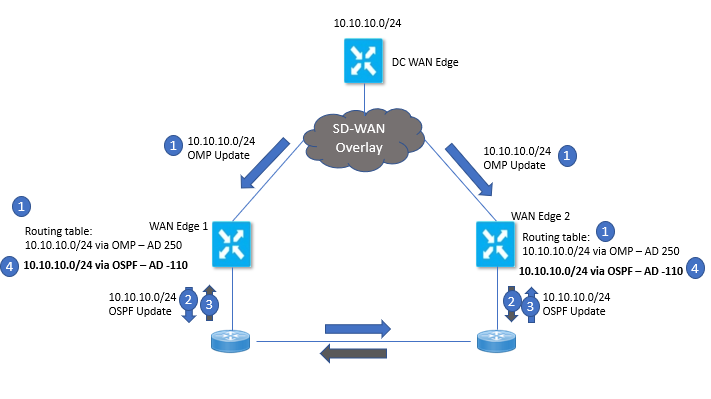
OMP has native built in loop prevention mechanism when interfacing with EIGRP, OSPF and BGP. Let’s see below steps, how OSPF Down bit can be utilized to prevent a routing loop.

Comment
-
RA
I am thrilled with the unicast routing course by DClesson. It covers everything that a beginner needs to master networking. It describes the architecture, components, operations, and security to scale for large, complex networks, and other important aspects. I am very much happy with the course, it has helped me a lot.
-
HE
If you are totally new to the concept of networking, this is a must-do course for you. This course has helped me install, troubleshoot, configure, and operate up to a medium-sized routed and switched network. I learned a lot from the course. This is a must-do course for everyone.




LEAVE A COMMENT
Please login here to comment.